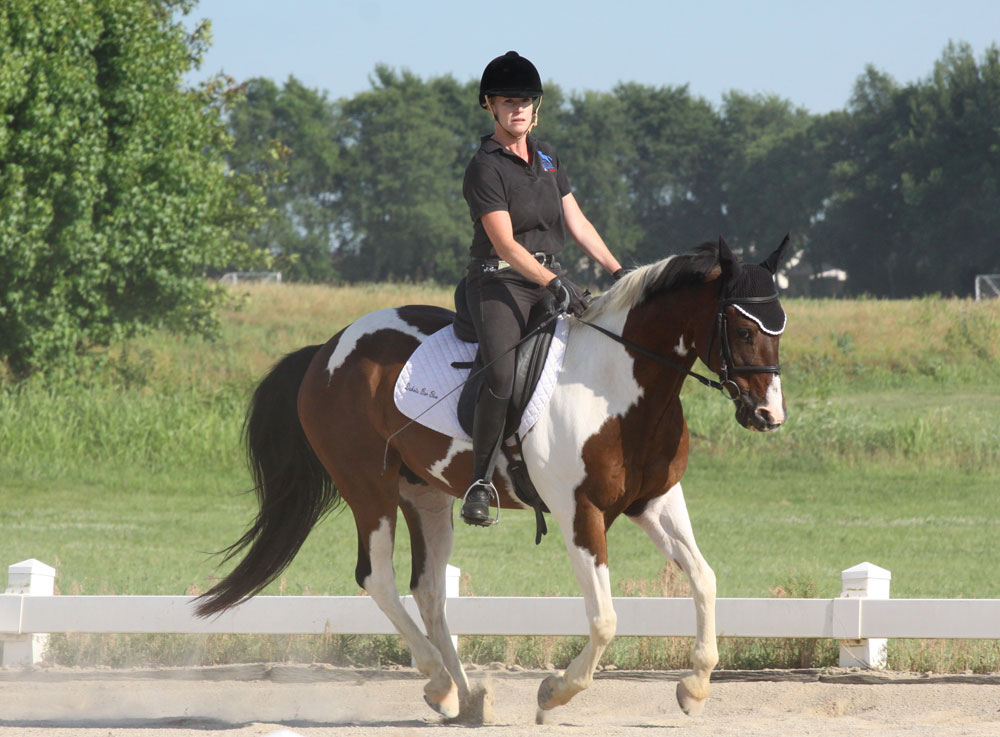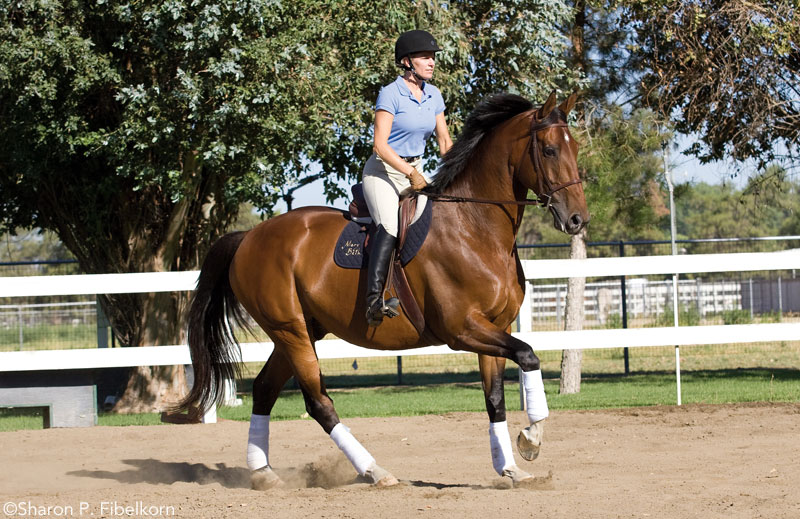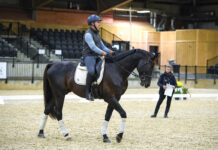Catch up with Part 1 of Julie Goodnight’s Canter Boot Camp series here.
Maintaining the canter can be difficult, follow these tips to learn how to keep the canter.
You can overcome these canter challenges which will aid in maintaining the canter when you understand how horses are trained and confidently cue your horse to move in the direction and at the speed you choose.
Setting Expectations
You shouldn’t have to tell your horse to keep going by constantly “pedaling,” or applying pressure with your legs. Your horse also shouldn’t speed up without a cue from you.
Breaking gait (slowing down to a walk or trot from the canter) is disobedient behavior. Many times, though, the horse thinks that he is doing the right thing by stopping making it harder to maintain the canter. A horse may sense a rider is out of balance or think that a fearful tug on the reins is a cue to stop.

However, a horse may also learn that he won’t be reprimanded for his disobedience if he does change gait at his own whim. It’s up to you, as the rider, to make sure you know when your horse is acting with disobedience and to make sure you aren’t interfering with your horse’s forward motion.
Causes for Breaking Gait
Balance and Rein Pressure:
Many times, horses learn that they can break gait at the canter when the rider inadvertently interferes by losing balance or unintentionally pulling on the reins. These mistakes make it difficult for the horse to keep moving forward at the canter.
Often, new riders are taught to canter in a small arena for the control and confinement it offers. Unfortunately, that usually means that as soon as you get going, you have to turn. The turn causes the rider to lose balance and pull on the reins. The combination of losing balance and pulling back on the reins to turn causes the horse to break gait.
Ideally, you should get comfortable cantering in straight lines, then start learning to turn with balance.
Ideally, you should get comfortable maintaining the canter in straight lines, then start learning to turn with balance. When you round a corner, make sure to reach forward and guide your horse through the turn using a leading rein and not a direct rein. Make sure that your heels are down and your arms are relaxed and reaching forward. This position will help you sit down into the saddle and be balanced so that you’re as easy as possible for your horse to carry.
If your horse has learned to stop cantering when you ask for a turn, make sure you’re not pulling back on the reins when you intend to provide a turning cue. You don’t want to pull back at the very moment he needs more forward impulsion to carry himself (and you) through the turn.
Worse, if you lean in and drop your hand low as you try to turn, you’ll pull your horse onto his forehand, making it impossible for him to sustain the canter. Sometimes even advanced riders cause their horse to break gait by simply making the turn too tight.
Keep two basic ideas in mind:
The faster the speed, the bigger the turn should be; and, the greener the horse, the larger the circle or wider the turn should be. Athletic and very well-trained horses are capable of carrying the rider at the slow collected canter in very small circles, but that comes with ability level of both rider and horse, plus conditioning and athleticism.
Make sure to give your horse plenty of slack in the reins as you cue for the canter. On the first canter stride, your horse reaches far down with his nose, requiring a release of the reins so that he won’t hit the bit and feel a tug on his mouth. If he hits the bit, he’s punished for doing what was asked and he feels pressure on his mouth, which tells him to stop.
The Lazy Horse
Some horses prefer to conserve their energy. Energy may be needed for a future flight response, so these horses move slowly until they need to move fast. If a rider gives this more-slow-than-go horse any reason to stop, he’ll take it as a great opportunity to avoid hard work.
If your horse is lazy, he may break gait and get to trot four or five strides. If you simply re-cue him without a reprimand, he will learn that he can get a break whenever he chooses. He got to catch his breath for a few strides and there was no penalty for breaking gait. Whenever the horse benefits from his behavior, he is likely to repeat it.
A horse that chooses to slow out of the canter to the trot should be corrected and immediately put back to the canter. If you don’t correct the horse (and only re-cue him for the canter), he has no way of knowing that you disapproved of his slowdown.
Make your horse notice that there’s a consequence for breaking gait. Only let him stop and rest when he is moving freely forward at the canter.
Your correction need not be harsh, but it needs to motivate your horse to change. Simply yelling “hey” or “get up” can prompt your horse to remember his training. As you re-cue him after a break in gait, ask him to work a little harder. Make him notice that there’s a consequence for breaking gait. Only let him stop and rest when he is moving freely forward at the canter.
If the breaking gait behavior persists, there is a simple reason—you are not using enough pressure to motivate change. Make sure the horse knows he is being corrected. If he isn’t noticing your reprimand, he’ll continue to do what he pleases—what’s easiest for him. Make your voice louder or pick up the ends of your reins to threaten a tap on the shoulder or hindquarters. Escalate your reprimand until you sense that your horse understands you.
Reward the Best
While you don’t want to push your horse beyond his physical fitness, you do want to make sure that you are the one making the choice to slow down.
If you only stop your horse when he is giving you what you want, he will always give you his best. He’ll learn that if he does what is asked, you’ll notice and reward him with a break. He’ll learn to trust you as his partner.

Whatever your issue at the canter, this simple training philosophy will work. Is your horse crow-hopping? Wait until he relaxes his back before you stop him. Is your horse moving too fast with his head high? Wait until you feel him slow down and relax; then stop him. Is he breaking gait? Wait until you feel him moving freely forward to stop him.
Just remember, whatever he’s doing at the moment you release him is what you just trained him to do.
Next month, Julie will help you gain confidence and improve your position while riding at the canter.
This article about maintaining the canter originally appeared in the May 2018 issue of Horse Illustrated magazine. Click here to subscribe!






